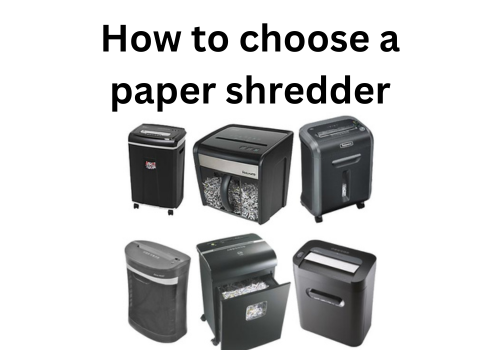
Choosing the right shredder is essential for effective document management and security. Consider these key factors to find the perfect shredder for your needs:
1. Shredding Capacity: Determine the volume of paper you need to shred regularly. Opt for a higher sheet capacity if you have a large volume of documents.
2. Shredding Type: Decide between strip-cut, cross-cut, or micro-cut shredders. Strip-cut offers basic security, while cross-cut and micro-cut provide higher levels of security by turning paper into tiny particles.
3. Security Level: Assess the sensitivity of your documents. Choose a shredder with a security level appropriate for your needs, especially if you handle confidential information.
4. Speed and Performance: Consider the shredder’s speed and continuous run time. Faster shredders with longer run times are ideal for heavy-duty use.
5. Additional Features: Look for features like auto-feed, reverse mode for clearing jams, and bin capacity indicator for convenience.
6. Size and Portability: Determine the space available for the shredder. Compact models are suitable for small spaces, while larger shredders offer higher capacities.
7. Brand Reputation and Warranty: Choose a reputable brand with good customer reviews and a warranty to ensure reliability and support.
At [Your Company], we offer a wide range of shredders to meet your specific requirements. Browse our selection to find the perfect shredder for your home or office!
Please Contact Us We Will Guide You to the Best Paper Shredder as per Your Need
Call or WhatsApp: +91 9820020714
Security Levels –
Material particle surface ≤ 800 mm2 or strip width ≤ 6 mm. Strip length not determined.Generally all strip cut shredders fall in this category
Material particle surface ≤ 320 mm2 (4 x 80 mm particles, for example) or strip width ≤ 2 mm. Strip length not determined.
Material particle surface ≤ 160 mm2 and for regular particles: strip width ≤ 6 mm (4 x 40 mm particles, for example).
Material particle surface ≤ 30 mm2 and for regular particles: strip width ≤ 2 mm (2 x 15 mm particles, for example).
Material particle surface ≤ 10 mm2 and for regular particles: strip width ≤ 1 mm (0.8 x 12 mm particles, for example).
Material particle surface ≤ 5 mm2 and for regular particles: strip width ≤ 1 mm (.8 x 5 mm particles, for example).
